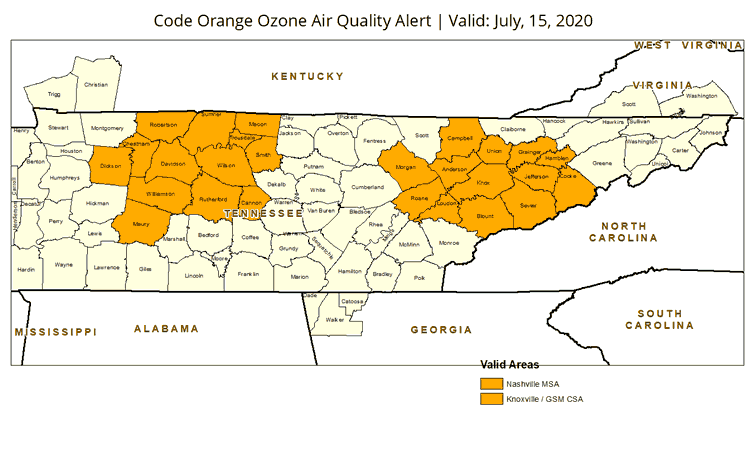The Tennessee Department of Environment and Conservation is issuing a Code Orange Air Quality Alert for ozone for the following areas, valid for July 15, 2020:
- Greater Nashville MSA
- Knoxville MSA
- Great Smoky Mountains National Park
Tomorrow, plan for ozone to reach levels in the lower end of the Unhealthy for Sensitive Groups range (101-150). Although general public is not likely to be affected at this AQI range, people with lung disease, older adults and children are at a greater risk from exposure to ozone.
Who is affected?
People with lung disease (including asthma), active adults and children are most affected by ground level ozone.
People with heart or lung disease, older adults and children are most at risk from exposure to particle pollution. Individuals in the above groups should consider cutting back or rescheduling strenuous outdoor activities until air quality improves. If you are sensitive to air pollution, check with your doctor for more specific steps you should take on Air Alert days.
Steps You Can Take to Reduce Air Pollution
Lose the Car Keys
Share a ride to work or use public transportation. Bring your lunch, or walk to lunch instead of getting in your car.
Drive Smart
Combine errands, skip the drive thru, limit engine idling, and avoid rush hour.
Don't Get Fired Up in the Yard
Avoid using gas-powered yard equipment, and save the grilling out for another day.
Steps You Can Take to Protect Your Health
This Air Quality Alert can include predicted high levels of ozone, fine particle pollution (PM2.5), or both.
The highest ozone levels usually occur from 2 p.m. to 7 p.m. in Middle Tennessee, so reschedule or cut back on outdoor activities, particularly during these times. Active children, active adults, and people with respiratory diseases are the most vulnerable.
Unhealthy levels of PM2.5 can occur at any time during the day. People with heart and lung disease, older adults and children are particularly at risk from exposure to fine particles. Cut back or reschedule strenuous outdoor activities when PM2.5 is predicted to be high.

